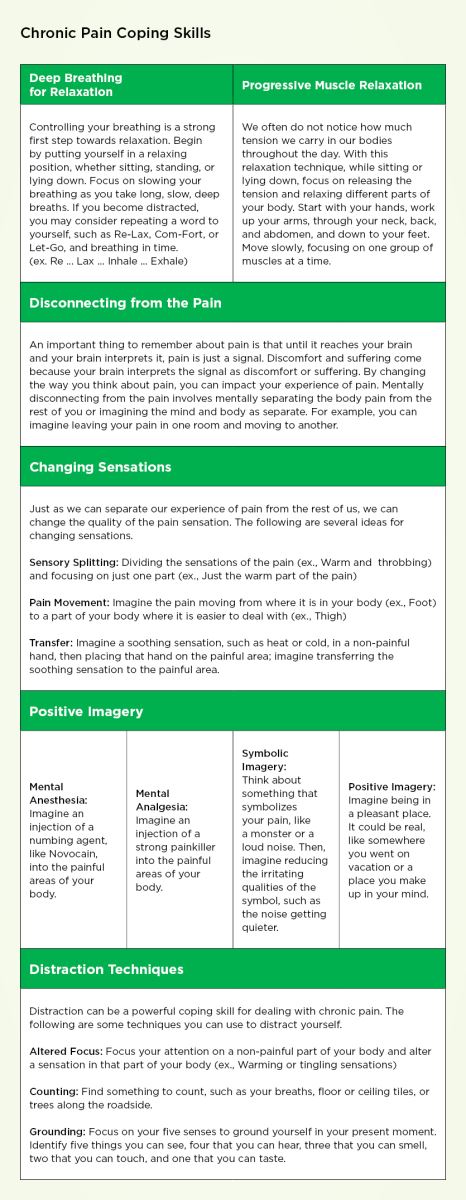
This post was written by Kelly Hutner, PsyD, HSPP, and Brian Hutner, PsyD, HSPP, PPG – Pain Management.
Pain perceptions can impact all areas of functioning, such as sleeping, eating, concentration, memory and activity level. They can also interfere with our jobs, hobbies, and social and family life. A comprehensive pain management plan is essential for maintaining quality of life and overall well-being. One method for coping with pain is distraction. Below, we'll outline common distraction techniques and offer some helpful exercises you can try to mitigate discomfort.
Distraction
Distraction tactics are coping strategies that aim to divert your attention from sources of stress or discomfort. This method works by deliberately redirecting your thoughts or actions to unrelated topics or activities. This can look like spending time doing hobbies, watching a movie or simply taking a walk to refocus your mind. Distraction tactics can be effective in providing temporary relief from pain.
Grounding
One distraction technique for managing pain is "grounding." This strategy, often recommended to calm anxiety, can help you reconnect with the present moment and reduce the intensity of pain perceptions. The 5-4-3-2-1 technique employs each of your senses, directing your attention away from the pain and towards your surroundings. Consider the following prompts to engage in the 5-4-3-2-1 method:
What are five things you can see?
-
Pay attention to the details and colors in your environment. If you are outside, what is in front of you? You might see birds flying by, green leaves on a tree or flowers starting to bloom.
-
If you're indoors, look at a photo on your phone of a loved one or favorite place. Close your eyes and visualize a place, person or pet who brings you joy and comfort.
What are four things you can feel?
-
Start with your clothing and how it feels against your skin.
-
Have a stress ball or a fidget spinner? Feel the texture of the item in your hand.
-
Some people find carrying a rock with a positive message comforting.
-
A religious object such as a cross or mala beads can be soothing during a difficult time.
-
Touch and hold your pet, hug a person or hold someone's hand.
What are three things you can hear?
-
Have a playlist ready with your favorite mood-boosting songs.
-
Step outside and listen to the ambient sounds of your environment.
-
Sing or hum your favorite tune.
What are two things you can smell?
-
Smell the flowers outside.
-
Experiment with essential oils like lavender or sandalwood for calming properties.
-
Put on your favorite hand lotion and activate touch and smell simultaneously.
What is one thing you can taste?
-
Chew a piece of gum or mint. Peppermint-flavored candies can help stimulate the mind.
-
Enjoy a cup of herbal tea or a small treat to engage your taste buds.
Breathing
Other distraction techniques involve actively focusing on your breath. Deep and controlled breathing can calm and divert the mind from discomfort. Breathing exercises can be done anytime, anywhere, by yourself or even with a partner or friend.
Next time you want to distract your mind from pain, give the 4-7-8 method a try:
-
Inhale: breathe in slowly through your nose, filling your lungs for 4 seconds.
-
Pause: Hold your breath for 7 seconds, allowing the oxygen to circulate throughout your body.
-
Exhale: Release the air completely through your mouth for 8 seconds.
You can also practice this breathing pattern to help reduce anxiety or encourage falling asleep. Adjust this rhythm to 2-4-6 or any combination if it is too difficult. With regular practice, your ability to hold and control your breath will improve. Customize the 4-7-8 method to your comfort level by sitting or lying with a pillow or stuffed animal. You can also place a small object on your stomach and watch it rise and fall with each breath to help maintain focus.
Final thoughts
We provide this coping skills menu to our patients to help them manage pain more effectively.

For patients with Parkview Physicians Group (PPG) – Pain Management, a session with a pain psychologist can be beneficial for learning practical coping tools. Appointments with PPG – Pain Management providers are by referral only. If you suspect you need to see a pain management provider, contact your primary care physician. To establish care with a PPG – Internal Medicine provider, schedule online or call our 24/7 scheduling center at 877-774-8632.



